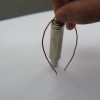Make a Homopolar Motor with Neodymium Magnets
The homopolar motor, the simplest electric motor, was first demonstrated by Michael Faraday in the early 1800s. His demonstration showed how electromagnetism can support motion, but the design used mercury and was not advanced enough to be used for any practical application. Nevertheless, his finding made the many advanced motor-based technologies that we see today possible. Today, magnets are used in electric motors to assist in transferring electrical energy to mechanical energy.
The founding principle behind the homopolar motor is the Lorentz force: when electric currents and magnetic fields are perpendicular to each other they can cause rotation. The magnet in the experiment creates the magnetic field needed to create this force. A traditional homopolar motor only has one current-carrying path, so it will continue in one fixed direction and strength.
It is because of its simple construction that the homopolar motor has been proposed for usage in ship propulsion and rail guns. However, in general, because other motors supply a higher voltage and have more sophisticated capabilities, many applications don't use the homopolar motor.
There are different variations of the homopolar motor, but for this tutorial we will start with a simple design.
Supplies
- Neodymium disc magnet
- Copper wire
- Wire cutters
- AA Battery
Instructions
- Lay out all of your supplies and cut the copper wire down so each end of it can loosely touch both sides of the battery. The wire should resemble something like a heart shape when bent around both ends of the battery.
- Once the wire is cut to size, attach the disc magnet to the negative side of the battery.
- Shape the wire to fit around the battery. The wire should be bent to touch the positive side of the battery while the cut ends of wire should both be touching the magnet.
- When both of the cut ends attach to the magnet and the other end of the battery is touching the wire. Be cautious because the wires should start spinning.

